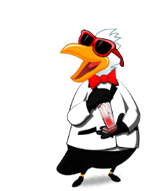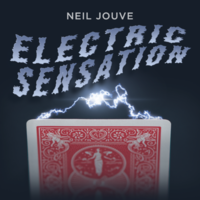
 Well worth every penny
Report this review
Well worth every penny
Report this review
Pro Privacy ON
(login to see reviewer names)
on July 12th, 2014
The seven Performances on JINXED are with strangers on the street or in venues in Greece and the
explanations for the effects are back at Titanas Magic with Vangelis Haralampous.
The DVD is broken down so that you can "play all" or just view the effects individually. If you choose to "play all" that viewing will also include the introduction and prologue. The explanations that follow each trick are more than just a simple "how to" but more of a "behind the scenes" theory about Peter's craft and how he's arrived at his ideas. Behind the scenes discussions include: building confidence, the gypsy peek, multiple outs, be bold, invisible force, updating the old, combining methods, versatility, peeks, mixing principles, Annemann plot, slate #1, slate #2 and more.....
Volume 1
0. Prologue - (15:09) Peter and Vangelis talk on the Titanas set. Peter sets up his premise for the DVD set and his appreciation for Theodore Annemann. The thing with these tricks on JINXED is - you're basically learning how Peter presents these classics. So don't expect to "learn" some revelational new methods on these DVDs. And I would argue that 90% of the magic that comes from these effects - the "reason" why they look like "magic" is Peter's presentation and his ability to work with strangers.
That is to say, usually with these new DVDs your excitement in purchasing them is to get to the "how" and you're hoping the "how" will help you. Peter isn't giving you new "how" he is giving you his approach and his take on perhaps many effects you have cast aside as "outdated" or "un doable."
For Peter it's not about "how" he is doing it, but rather "why" he's doing it and how it relates back to his performance.
In all fairness - I bet some people will be disappointed that there aren't more earth-shattering revelations here. But I think if people are willing to really examine the content, of what Peter is trying to get across - this is really an argument to revisit the books on your bookshelf and to not dismiss the classic effects because they seem to use an outdated element. Peter strips all that away and asks "why did this work -THEN - and how could it work now?" What is the "thing" behind THE THING?
For instance, I read a mentalist routine once in a Karl Fulves book where the Magi leaves the room and then goes into a bedroom and closes a door so that his house guests could choose a random object. The "secret" was that the Magi stared through the keyhole and watched to see what "item" in the room the house guests chose. I could dismiss that effect and say "well, house doors don't have keyholes you can see through anymore." True, but... what's the principle? Having a way to "spy" on the room. What would we do in today's culture? Set up a Nanny cam! Put a hidden camera in there with a feed coming straight into your bedroom!
One last thing - as these tricks involve mentalism and mind-reading - these effects are more geared to the walk-around, or the table hopper magician and not for someone who does magic for friends and family.
1. A Question and an Answer (Performance 9:27/ Explanation 17:31) / a hybrid from Practical Mental Effects where Peter divines a written answer that is sealed away in a stack of envelopes.
Review: masterful in Peter's hand, Peter combines a cold-reading with a divining method using a "secret" most beginning mentalists already know.
2. Life Equation (Performance 6:02 / Explanation 25:18) using a cell phone calculator guide the spectator through a series of special numbers to arrive at a personal integer that is later predicted by the magician.
Review: a hybrid from 202 Methods of Forcing. Again, another very familiar method. I think this trick was in my very first beginner's magic book from the 1950s. (Simple Tricks for the Young Magician by Green) Like the previous effect - you're learning Peter's routine and watching how a master crafts these classics for the modern age.
3. Rosie Red (Performance 2:43 / Explanation 47:05) this is a slate prediction effect that requires an audience.
Review: a reworking of an effect from Practical Mental Effects. Admittedly when I learned Peter's method for this effect, it was kind of a let down - it's not an effect I would do - but what I loved was the explanation after the explanation. In the video that follows Peter covers a myriad of equivocate and forcing techniques.
Volume 2
1. Finger Finger (Performance 4:37 / Explanation 12:41) an impromptu number guessing game.
Review: a variation of an effect from The Jinx. At first it doesn't feel like a "trick" and Peter does not sell it as such, more than it's a way to build rapport with a spectator. But if it hits - it hits BIG
2. Cigarette Divination (performance 2:37 / Explanation 17:02) The spectator removes a random amount of cigarettes and you are able to discern how many they took.
Review: a variation from The Jinx originally done with matches, a wonderful foresight effect that anyone who does bar magic or cigarette magic will instantly adopt into their routine.
3. A Lock and Keys (performance 4:12 / Explanation 13:11) Peter guesses a spectator's written cellphone unlock key from a series of cards.
Review: Peter's take on Anneman's "Seven Keys to Baldpate" & Henry Fischer's "Lock and Keys." A trick using a cell phone adopting a method devised before the telephone was ever invented.
4. A Slate and a Number (performance 24:10/ Explanation 7:12) Peter performs this with three spectators divining numbers, pictures and birthdays.
Review: a passed over effect from Practical Mental Effects. Peter develops a beautiful routine you can do with a group of people - easily a closer that would solidify you as a mental savant.
End Review (5:04 minutes) "This for me is a little about telepathy as it as much about empathy" Peter Turner.
My advice - buy the book "Practical Mental Effects" along with this DVD.
Here is my video review: https://www.youtube.com/watch?v=eh-7jW4BP3I
The DVD is broken down so that you can "play all" or just view the effects individually. If you choose to "play all" that viewing will also include the introduction and prologue. The explanations that follow each trick are more than just a simple "how to" but more of a "behind the scenes" theory about Peter's craft and how he's arrived at his ideas. Behind the scenes discussions include: building confidence, the gypsy peek, multiple outs, be bold, invisible force, updating the old, combining methods, versatility, peeks, mixing principles, Annemann plot, slate #1, slate #2 and more.....
Volume 1
0. Prologue - (15:09) Peter and Vangelis talk on the Titanas set. Peter sets up his premise for the DVD set and his appreciation for Theodore Annemann. The thing with these tricks on JINXED is - you're basically learning how Peter presents these classics. So don't expect to "learn" some revelational new methods on these DVDs. And I would argue that 90% of the magic that comes from these effects - the "reason" why they look like "magic" is Peter's presentation and his ability to work with strangers.
That is to say, usually with these new DVDs your excitement in purchasing them is to get to the "how" and you're hoping the "how" will help you. Peter isn't giving you new "how" he is giving you his approach and his take on perhaps many effects you have cast aside as "outdated" or "un doable."
For Peter it's not about "how" he is doing it, but rather "why" he's doing it and how it relates back to his performance.
In all fairness - I bet some people will be disappointed that there aren't more earth-shattering revelations here. But I think if people are willing to really examine the content, of what Peter is trying to get across - this is really an argument to revisit the books on your bookshelf and to not dismiss the classic effects because they seem to use an outdated element. Peter strips all that away and asks "why did this work -THEN - and how could it work now?" What is the "thing" behind THE THING?
For instance, I read a mentalist routine once in a Karl Fulves book where the Magi leaves the room and then goes into a bedroom and closes a door so that his house guests could choose a random object. The "secret" was that the Magi stared through the keyhole and watched to see what "item" in the room the house guests chose. I could dismiss that effect and say "well, house doors don't have keyholes you can see through anymore." True, but... what's the principle? Having a way to "spy" on the room. What would we do in today's culture? Set up a Nanny cam! Put a hidden camera in there with a feed coming straight into your bedroom!
One last thing - as these tricks involve mentalism and mind-reading - these effects are more geared to the walk-around, or the table hopper magician and not for someone who does magic for friends and family.
1. A Question and an Answer (Performance 9:27/ Explanation 17:31) / a hybrid from Practical Mental Effects where Peter divines a written answer that is sealed away in a stack of envelopes.
Review: masterful in Peter's hand, Peter combines a cold-reading with a divining method using a "secret" most beginning mentalists already know.
2. Life Equation (Performance 6:02 / Explanation 25:18) using a cell phone calculator guide the spectator through a series of special numbers to arrive at a personal integer that is later predicted by the magician.
Review: a hybrid from 202 Methods of Forcing. Again, another very familiar method. I think this trick was in my very first beginner's magic book from the 1950s. (Simple Tricks for the Young Magician by Green) Like the previous effect - you're learning Peter's routine and watching how a master crafts these classics for the modern age.
3. Rosie Red (Performance 2:43 / Explanation 47:05) this is a slate prediction effect that requires an audience.
Review: a reworking of an effect from Practical Mental Effects. Admittedly when I learned Peter's method for this effect, it was kind of a let down - it's not an effect I would do - but what I loved was the explanation after the explanation. In the video that follows Peter covers a myriad of equivocate and forcing techniques.
Volume 2
1. Finger Finger (Performance 4:37 / Explanation 12:41) an impromptu number guessing game.
Review: a variation of an effect from The Jinx. At first it doesn't feel like a "trick" and Peter does not sell it as such, more than it's a way to build rapport with a spectator. But if it hits - it hits BIG
2. Cigarette Divination (performance 2:37 / Explanation 17:02) The spectator removes a random amount of cigarettes and you are able to discern how many they took.
Review: a variation from The Jinx originally done with matches, a wonderful foresight effect that anyone who does bar magic or cigarette magic will instantly adopt into their routine.
3. A Lock and Keys (performance 4:12 / Explanation 13:11) Peter guesses a spectator's written cellphone unlock key from a series of cards.
Review: Peter's take on Anneman's "Seven Keys to Baldpate" & Henry Fischer's "Lock and Keys." A trick using a cell phone adopting a method devised before the telephone was ever invented.
4. A Slate and a Number (performance 24:10/ Explanation 7:12) Peter performs this with three spectators divining numbers, pictures and birthdays.
Review: a passed over effect from Practical Mental Effects. Peter develops a beautiful routine you can do with a group of people - easily a closer that would solidify you as a mental savant.
End Review (5:04 minutes) "This for me is a little about telepathy as it as much about empathy" Peter Turner.
My advice - buy the book "Practical Mental Effects" along with this DVD.
Here is my video review: https://www.youtube.com/watch?v=eh-7jW4BP3I
Add a comment
OPEN BOX
$6.35 (68% OFF)
59
Bestsellers
See all bestsellers
COOL BOX
7% now claimed
0
5
:
4
2
:
2
0
remaining

Act Builder beta




























